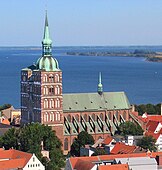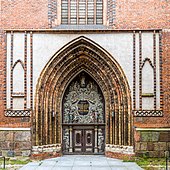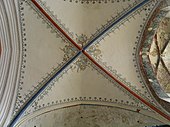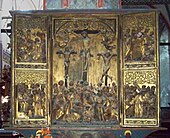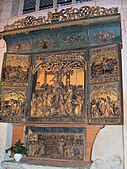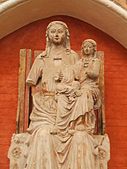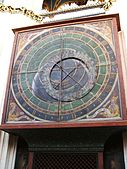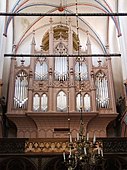
The Catholic Cathedral Church of St. John (Sint-Janskathedraal) of 's-Hertogenbosch, North Brabant, is the height of Gothic architecture in the Netherlands. It has an extensive and richly decorated interior, and serves as the cathedral for the bishopric of 's-Hertogenbosch.

Bourges Cathedral is a Roman Catholic church located in Bourges, France. The cathedral is dedicated to Saint Stephen and is the seat of the Archbishop of Bourges. Built atop an earlier Romanesque church from 1195 until 1230, it is largely in the High Gothic architectural style and was constructed at about the same time as Chartres Cathedral. The cathedral is particularly known for the great size and unity of its interior, the sculptural decoration of its portals, and the large collection of 13th century stained glass windows. Owing to its quintessential Gothic architecture, the cathedral was declared a UNESCO World Heritage Site in 1992.

The Lübeck Marienkirche is a medieval basilica in the city centre of Lübeck, Germany. Built between 1265 and 1352, the church is located on the highest point of Lübeck's old town island within the Hanseatic merchants' quarter, which extends uphill from the warehouses on the River Trave to the church. As the main parish church of the citizens and the city council of Lübeck, it was built close to the town hall and the market.

St. Peter's Church, in German Petrikirche, was built in the 13th century and is the oldest of three town churches found in the Hanseatic city of Rostock, in northern Germany. The other two are St. Mary's Church (Marienkirche) and St. Nicholas (Nikolaikirche). A fourth, St. Jakobi, was heavily damaged during the Second World War and subsequently demolished.

St Peter's Cathedral is a Roman Catholic church and former cathedral in Worms, southern Germany.
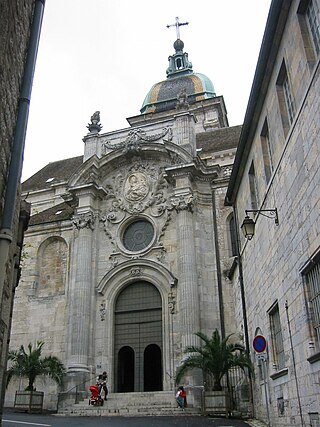
Besançon Cathedral is a Roman Catholic church dedicated to Saint John located in the city of Besançon, France. It is the seat of the Archbishop of Besançon.

Wimborne Minster is the parish church of Wimborne, Dorset, England. The minster has existed for over 1300 years and is recognised for its unusual chained library. The minster is a former monastery and Benedictine nunnery, and King Æthelred of Wessex is buried there.

St Nicholas Church is a Church of England parish church in Kenilworth, Warwickshire, England.

St Peter's Church is the parish church of Prestbury, Cheshire, England. It is probably the fourth church on the site. The third, the Norman Chapel, stands in the churchyard. The church is recorded in the National Heritage List for England as a designated Grade I listed building. The Norman Chapel, the lychgate and west wall, the Hearse House, and the sundial in the churchyard are listed at Grade II. It is a Church of England parish church in the diocese of Chester, the archdeaconry of Macclesfield and the deanery of Macclesfield.

St. Nicholas Church is a medieval church building in Tallinn (Reval), Estonia. It was dedicated to Saint Nicholas, the patron of the fishermen and sailors. Originally built in the 13th century, it was partially destroyed in the Soviet bombing of Tallinn in World War II. The building itself has since been restored, however, as a church without own congregation, it has not been used for regular religious activities since World War II. At present it houses the Niguliste Museum, a branch of the Art Museum of Estonia, focusing mainly on ecclesiastical art from the Middle Ages onward. It is also used as a concert hall.
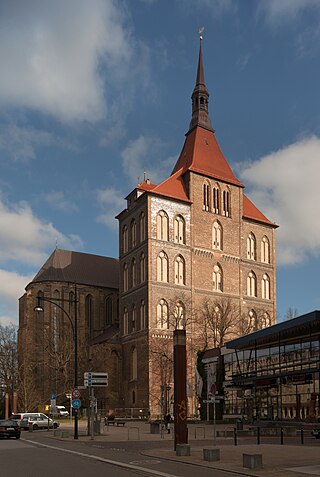
St. Mary's Church, Rostock, in German Marienkirche, is the biggest of three town churches found in the Hanseatic city of Rostock, in northern Germany. The other two are St. Peter's (Petrikirche) and St. Nicholas (Nikolaikirche). A fourth, St. James' (Jakobikirche), was heavily damaged during the Second World War and subsequently demolished. St. Mary's was designated in 1265 as the main parish church. Since the Protestant Reformation in 1531, it houses a congregation of the Evangelical Lutheran State Church of Mecklenburg.

The Parish Church of St Mary the Virgin is a Church of England parish church in Leigh, Greater Manchester, England. It is a member of the Salford & Leigh deanery in the archdeaconry of Salford, diocese of Manchester. It is recorded in the National Heritage List for England as a designated Grade II* listed building.

St Martin's Cathedral is a cathedral in Slovakia. It is located in the town of Spišská Kapitula and is the cathedral church of the Spiš diocese.

Münster Cathedral or St.-Paulus-Dom is the cathedral church of the Catholic Diocese of Münster in Germany, and is dedicated to St Paul. It is counted among the most significant church buildings in Münster and, along with the City Hall, is one of the symbols of the city.
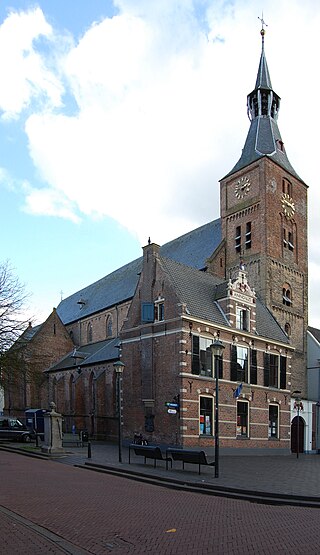
The Grote of Andreaskerk is the oldest church building of Hattem. It is situated in the city centre. It is used by the Reformed Protestant community of Hattem for holding church services. Organ concerts and other musical events are also organised in the building.

St Nicholas of Wismar was built from 1381 until 1487 as a church for sailors and fishermen. St Nicholas is one of the finest testaments to mediaeval brick architecture in northern Germany.

St. Nikolai, Greifswald, dedicated to Saint Nicholas, the patron saint of seafarers and merchants, is a Brick Gothic church located in the western part of the centre of Greifswald. It was the main church and seat of the bishop of the Pomeranian Evangelical Church.

St. Nikolai is the name of a Protestant parish and its church in Kiel, the capital of Schleswig-Holstein, Germany. It is the town's oldest building, at the Alter Markt. It was dedicated to Saint Nicholas. In the 19th century, it was remodeled in Gothic Revival style. Destroyed in World War II, it was rebuilt with a simpler contemporary interior. It features notable artworks such as a bronze baptismal font from 1340, an altar from 1460, a triumphal cross from 1490, a wood-carved pulpit from 1705, and outside a bronze by Ernst Barlach from 1928.

The St. Nikolai church is the largest medieval church in Jüterbog, Brandenburg, Germany. The nave is a Brick Gothic hall church construction with field stone dual towers that dominate the cityscape. The church was first mentioned in 1307 and likely consecrated in 1488. The Patron saint is St. Nicholas of Myra.

The astronomical clock of St. Nicholas Church, Stralsund is a 14th century monumental astrolabe clock. It was probably damaged in the 16th century, and has not worked since then. It is the only clock of its kind to have been preserved almost entirely in its original condition. The clockwork and the indications have not been restored.



